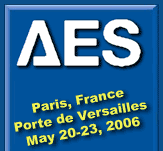

Home | Technical Program | Exhibition | Visitors | Students | Press
Last Updated: 20060417, saj
Saturday, May 20, 09:00 — 11:00W2 - FROM 5.1 TO FIELD SYNTHESIS: COMPATIBLE CAPTATION AND RESTITUTION SYSTEMS
Chair:
Angelo Farina
Panelists:
Jérôme Daniel, France Telecom R&D
Arnaud Laborie, Trinnov Audio
Renato Pellegrini, Sonic Emotion
Günther Theile, IRT
Abstract:
Traditionally, spatial recording and reproduction had been possible with several approaches:
— Binaural, which has the great advantage fo being stereo-compatible by definition
— Ambisonics, providing a good result for a little number of channels (2, 3 or 4), but requiring encoding and decoding at both ends of the transmission chain.
— "Cinema" style discrete 5.1 surround, which is very simple to understand and implement (each channel is fed by one microphone, and is delivered to one loudspeaker), but produces results quite worst than the first two methods.
— WFS or other wavefront reconstruction systems, requiring large arrays of closely-spaced loudspeakers, and being usable only with synthesized soundtracks (a WFS microphone has not yet been developed fully).
For several years the four systems above did compete. Discrete 5.1 substantially won the battle regarding the soundtrack of films and videos, but the mass production of music in 5.1 format never did start, also due to the "war format" between DTS-CD, DVD-audio, and SACD. Only musical DVD-videos have been mass-produced until now. Binaural, Ambisonics, and WFS systems were used just in research labs or in sophisticated theme parks.
Now a novel method approaches the scene: HOA (High Order Ambisonics). This is not as inexpensive as 1st-order Ambisonics, as now the channel count is between 16 and 25. But it is still much lower than what required by WFS, and HOA is a full 3-D system, while WFS is horizontal-only. This means that the HOA candidate is the practical winner in a new arena: computer-driven sound recording and reproduction. This is a field that is rapidly growing, both for musicians and for end-listeners. The number of recording or playback sound systems that incorporate a powerful PC is increasing steadily, and the next generation of "silent" computers, based on low-power dual-core processors (initially developed for laptop computers) will win the last barrier preventing computers to be used as the main "music machine" in any environment: the fan noise.
The goal of this workshop is to explore what can be already done now, addressing the huge installed base of "home theater" systems configured (more or less properly) for playback of discrete 5.1 soundtracks: do these new "high resolution" methods still provide significant advantages for creation and delivery of musical content, or we need to wait the next generation of computer-based home media centers for exploiting their full
potential?